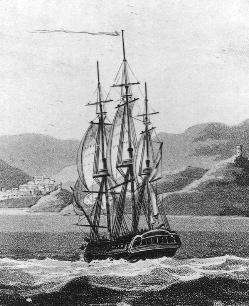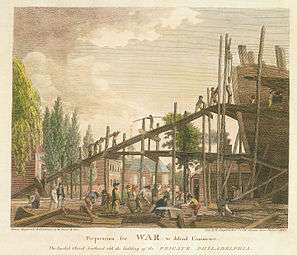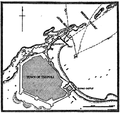USS Philadelphia (1799)
 | |
| History | |
|---|---|
| Name: | USS Philadelphia |
| Cost: | $179,349 |
| Laid down: | November 14, 1798 |
| Launched: | November 28, 1799 |
| Commissioned: | April 5, 1800 |
| Fate: | Captured October 31, 1803, re-captured and burned by the U.S. Navy February 16, 1804 |
| General characteristics | |
| Class and type: | Philadelphia-class frigate |
| Tonnage: | 1240 |
| Length: | 157 ft (48 m) between perpendiculars[1] |
| Beam: | 39 ft (12 m) |
| Depth: | 13 ft 6 in (4.11 m) |
| Complement: | 307 officers and crew |
| Armament: |
|
USS Philadelphia, a 1240-ton, 36-gun sailing frigate, was the second vessel of the United States Navy to be named for the city of Philadelphia. Originally named City of Philadelphia, she was built in 1798–1799 for the United States government by the citizens of that city. Funding for her construction was the result of a funding drive which raised $100,000 in one week, in June 1798.[2] She was designed by Josiah Fox and built by Samuel Humphreys, Nathaniel Hutton and John Delavue. Her carved work was done by William Rush of Philadelphia.[3] She was laid down about November 14, 1798, launched on November 28, 1799, and commissioned on April 5, 1800, with Captain Stephen Decatur, Sr. in command.[4] She is perhaps best remembered for her burning after being captured in Tripoli.
Service history
Putting to sea for duty in the West Indies to serve in the Quasi-War with France, she arrived on the Guadeloupe Station in May 1800 and relieved the frigate Constellation. During this cruise she captured five French armed vessels and recaptured six merchant ships that had fallen into French hands.
Returning home in March 1801, she was ordered to prepare for a year's cruise in the Mediterranean in a squadron commanded by Commodore Richard Dale. At his own request, Decatur was relieved of the command of President by Captain Samuel Barron. The squadron arrived at Gibraltar on July 1, with Commodore Dale in the frigate President. Philadelphia was directed to cruise the Straits and blockade the coast of Tripoli, the Pasha Yusuf Karamanli having threatened to wage war on the United States.
Philadelphia departed Gibraltar for the United States in April 1802, arriving in mid-July.[5] In ordinary until May 21, 1803, when she recommissioned (having her sixteen 9-pounder long guns replaced with sixteen 32-pounder carronades at this time), and sailed for the Mediterranean on July 28, 1803. She arrived in Gibraltar on August 24 with Captain William Bainbridge in command, and two days later recaptured the American brig Celia from the Moroccan ship-of-war Mirboka (24 guns and 100 men), and brought them both into Gibraltar.
Destruction
During the First Barbary War Philadelphia cruised off Tripoli until October 31, 1803, while giving chase and firing upon a pirate ship she ran aground on an uncharted reef two miles off Tripoli Harbor. The Captain, William Bainbridge, tried to refloat her, first laying the sails back, and casting off three bow anchors and shifting the guns rear-ward. But a strong wind and rising waves drove her further aground. Next they dumped many of her cannons, barrels of water, and other heavy articles overboard in order to make her lighter but this too failed. They then sawed off the foremast in one last desperate attempt to lighten her. All of these attempts failed and Bainbridge, in order not to resupply the pirates, ordered holes drilled in the ship's bottom, gunpowder dampened, sheets set afire and all other weapons thrown overboard before surrendering. Her officers and men were made slaves of the Pasha (or Bashaw).[6]
Philadelphia, which had been refloated by her captors, was too great a prize to be allowed to remain in the hands of the Tripolitanians, so a decision was made to recapture or destroy her. The U.S. had captured the Tripolitanian ship Mastico, renamed USS Intrepid and re-rigged with short masts and triangular sails to look like local ships, under the cover of night and under the guise of a ship in distress in need of a place to tie up after having lost all anchors in a storm, on February 16, 1804, a volunteer assaulting party of officers and men under Lieutenant Stephen Decatur, Jr. boarded her from the ketch Intrepid and after making sure that Philadelphia was not seaworthy burned her where she lay in Tripoli Harbor. Lord Horatio Nelson, known as a man of action and bravery, is said to have called this "the most bold and daring act of the Age."[7][8]
Her anchor was returned to the United States on April 7, 1871, when the Bashaw presented it to the captain of the visiting Guerriere.
 "Preparation for War to defend Commerce ... the building of the Frigate Philadelphia," Birch's Views of Philadelphia (1800).
"Preparation for War to defend Commerce ... the building of the Frigate Philadelphia," Birch's Views of Philadelphia (1800). Philadelphia in the harbor of Tripoli, February 16, 1804.
Philadelphia in the harbor of Tripoli, February 16, 1804. (A) is the location of the wreck of Philadelphia at the time she was fired by Decatur. The dashed line is Decatur's route. (B) is the final resting place of Philadelphia after drifting and burning.
(A) is the location of the wreck of Philadelphia at the time she was fired by Decatur. The dashed line is Decatur's route. (B) is the final resting place of Philadelphia after drifting and burning.
Local account of the destruction
In 1904, Charles Wellington Furlong, an American adventurer went to Tripoli to investigate the sinking of Philadelphia and later wrote of it in his book, The Gateway to the Sahara: Observations and Experiences in Tripoli (1909). In this book the following account, based on records from a local synagogue, is given:
Yusef Pashaw had equipped a number of corsairs.... His captains, Zurrig, Dghees, Trez, Romani and El-Mograbi, set sail from Tripoli and shortly sighted an American vessel [Philadelphia]. Zurrig left the others and daringly approached the ship, annoying her purposely to decoy her across the shoals. She stranded, but fired on the other vessels until her ammunition gave out, whereupon the Moslems pillaged her. The American Consul [actually the Danish consul, Nissen] was very much disheartened and tried to conclude arrangements similar to those recently made between the Bashaw and the Swedish Consul; but such an enormous tribute was demanded that no terms could be reached, so by order of the Bashaw the vessel was burned.
Furlong later reports in the same book, that he talked to other Arabs in Tripoli who said that the ship was not burned, but moved to the Lazaretto where it was dressed up as a trophy and its guns used to call to prayer. According to these accounts the ship had 10 guards and an American ketch was able to sneak in, kill the guards, and set the ship on fire before anything could be done.
See also
- List of sailing frigates of the United States Navy
- List of ships captured in the 19th century
- Bibliography of early American naval history
References
- ↑ Chapelle 1949, p. 549.
- ↑ Canney, 2001, p. 52.
- ↑ Toll, 2006, pp. 52–54.
- ↑ Tucker, 1937, p. 17.
- ↑ Tucker, 1937, p. 39.
- ↑ Kilmeade & Yaeger, pp. 121–124.
- ↑ Tucker, 1937, p. 57.
- ↑ MacKenzie, 1846, pp. 331–335.
- This article incorporates text from the public domain Dictionary of American Naval Fighting Ships. The entry can be found here.
Bibliography
- Cooper, James Fenimore (1826). History of the Navy of the United States of America. Stringer & Townsend, New York. p. 508. OCLC 197401914. Url
- Hill, Frederic Stanhope (1905). Twenty-six historic ships. G. P. Putnam's Sons, New York and London. p. 515. OCLC 1667284. Url
- Tucker, Spencer (2004). Stephen Decatur: a life most bold and daring. Naval Institute Press, 2004, Annapolis, Maryland. p. 245. ISBN 1-55750-999-9.
- Mackenzie, Alexander Slidell (1846). Life of Stephen Decatur: a commodore in the Navy of the United States. C. C. Little and J. Brown, 1846.
- Toll, Ian W. (2006). Six frigates: the epic history of the founding of the U.S. Navy. W. W. Norton & Company, New York. p. 500. ISBN 978-0-393-05847-5. Url
- Canney, Donald L. (2001). Sailing warships of the US Navy. Chatham Publishing / Naval Institute Press. p. 224. ISBN 1-55750-990-5. Url
Further reading
- Chapelle, Howard I. (1935) The American Sailing Navy, W. W. Norton and Co., New York, p. 400, Book
- Kilmeade, Brian & Yaeger, Don (2015) Thomas Jefferson and the Tripoli Pirates: The Forgotten War That Changed American History. Sentinel., New York, ISBN 978-1-59184-806-6.
- London, Joshua E. (2011) Victory in Tripoli: How America's War with the Barbary Pirates Established the U.S. Navy and Shaped a Nation, John Wiley & Sons, Inc., New Jersey, p. 288, ISBN 0-471-44415-4, Book
- Oren, Michael B. (2007) Power, Faith, and Fantasy, Chapter 3, W. W. Norton and Co., New York, ISBN 0-393-05826-3.
- Willis, Sam (2007). Fighting Ships: 1750–1850, Quercus Books, London.
- Zachs, Richard (2005). The Pirate Coast: Thomas Jefferson, the First Marines, and the Secret Mission of 1805, Hyperion, New York.